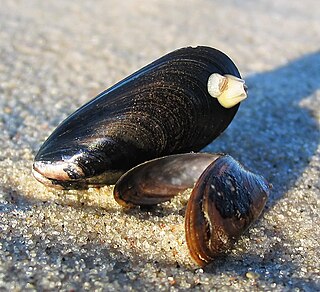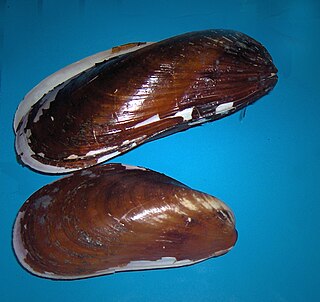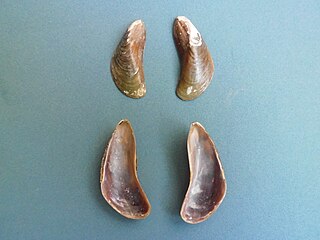
A cold seep is an area of the ocean floor where seepage of fluids rich in hydrogen sulfide, methane, and other hydrocarbons occurs, often in the form of a brine pool. Cold does not mean that the temperature of the seepage is lower than that of the surrounding sea water; on the contrary, its temperature is often slightly higher. The "cold" is relative to the very warm conditions of a hydrothermal vent. Cold seeps constitute a biome supporting several endemic species.

The Hikurangi Trough is a sea floor feature of the Pacific Ocean off the north-east South Island and the east coast of the North Island of New Zealand. It has been forming for about 25 million years and is turbidite-filled, particularly in its south. This characteristic can be used to distinguish it from the sediment-poor and deeper Kermadec Trench, which is its continuation to the north. Sediment currently passing through the trough represents about 0.5% of the total sediment input to the world oceans. The trough has deep-sea chemosynthetic ecosystems that are unique.

Mytilidae are a family of small to large marine and brackish-water bivalve molluscs in the order Mytilida. One of the genera, Limnoperna, even inhabits freshwater environments. Mytilidae, which contains some 52 genera, is the only extant family within the order Mytilida.
The Ochlockonee moccasinshell is a species of freshwater mussel, an aquatic bivalve mollusk in the family Unionidae, the river mussels.
Freshwater bivalves are molluscs of the order Bivalvia that inhabit freshwater ecosystems. They are one of the two main groups of freshwater molluscs, along with freshwater snails.

Vesicomyidae is a family of saltwater clams, marine bivalve molluscs in the superfamily Glossoidea.

Lucinidae, common name hatchet shells, is a family of saltwater clams, marine bivalve molluscs.

Gigantidas is a genus of large, deepwater, hydrothermal vent mussels, marine bivalve molluscs in the family Mytilidae.

Modiolus modiolus, common name northern horsemussel, is a species of marine bivalve mollusk in the family Mytilidae.
Thalassonerita is a monotypic genus of sea snails, marine gastropod mollusks in the family Neritidae. Its sole species is Thalassonerita naticoidea. T. naticoidea is endemic to underwater cold seeps in the northern Gulf of Mexico and in the Caribbean. Originally classified as Bathynerita, the genus was reassessed in 2019 after Thalassonerita was found to be a senior synonym of Bathynerita.

Bathymodiolus childressi is a species of deepwater mussel, a marine bivalve mollusk species in the family Mytilidae, the mussels.

Bathymodiolus is a genus of deep-sea mussels, marine bivalve molluscs in the family Mytilidae. Many of them contain intracellular chemoautotrophic bacterial symbionts.

Perna is a genus of mussels, marine bivalve molluscs in the family Mytilidae.

Bathymodiolus thermophilus is a species of large, deep water mussel, a marine bivalve mollusc in the family Mytilidae, the true mussels. The species was discovered at abyssal depths when submersible vehicles such as DSV Alvin began exploring the deep ocean. It occurs on the sea bed, often in great numbers, close to hydrothermal vents where hot, sulphur-rich water wells up through the floor of the Pacific Ocean.

Bathymodiolus marisindicus is a species of deepwater hydrothermal vent mussel, a marine bivalve mollusk species in the family Mytilidae, the mussels. This species is found in the Indian Ocean.

Mytella strigata is a bivalve, commonly known as the charru mussel or charrua mussel. This species was described by Sylvanus Charles Thorp Hanley based on a specimen from the Philippines. It was found in Central and South America and by Alcide d'Orbigny, a French naturalist, in 1842, where it was assigned the synonym Mytilus charruanus. They are less than an inch long (2.5 cm), and range from brown to black in color.

Modiolus capax, common name fat horsemussel, is a species of "horse mussel", a marine bivalve mollusc in the family Mytilidae, the mussels. It was first described to science by American malacologist Timothy Abbott Conrad in 1837. The type specimen was collected in San Diego by Thomas Nuttall.

Arcuatula senhousia(= Musculista senhousia), commonly known as the Asian date mussel, Asian mussel or bag mussel, is a small saltwater mussel, a marine bivalve mollusk species in the family Mytilidae, the mussels. Other common names for this species include: the Japanese mussel, Senhouse's mussel, the green mussel, and the green bagmussel. It is harvested for human consumption in China.

Bathymodiolus platifrons, described by Hashimoto and Okutani in 1994, is a deep-sea mussel that is common in hydrothermal vents and methane seeps in the Western Pacific Ocean.

Sinupharus is a genus of bivalves, belonging to the family Pharidae.

















